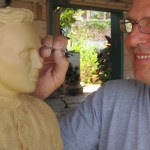 Damiaan Donker, a dark Belgian ale, is named after St. Damien de Veuster of Molokai, Hawaii. The 19th-century Belgian missionary ministered to people with leprosy in Hawaii.
Damiaan Donker, a dark Belgian ale, is named after St. Damien de Veuster of Molokai, Hawaii. The 19th-century Belgian missionary ministered to people with leprosy in Hawaii.
Damien beer honors its saintly namesake. By DARLENE J.M. DELA CRUZ | Catholic News Service
HONOLULU — First, a couple of schools. Then, several U.S. parishes. Now ... a fine craft beer?
Many things have been named after St. Damien de Veuster of Molokai, but none was more surprising than a recent discovery at a Whole Foods store in Hawaii -- a bottle of Belgian ale labeled with the likeness of St. Damien.
The beer is called "Damiaan Donker." The name pairs the Dutch words for "Damien" and "dark, strong ale."
A question printed on the back of a Damiaan Donker bottle anticipates what inquiring minds want to know: "Is it right to honor a saint with a beer?" The beer's creator, chef Donato Loperfido, explained to the Hawaii Catholic Herald, Honolulu diocesan newspaper, why he thinks it is.
Loperfido is a lifelong Catholic who originally hails from Puglia, Italy. He has lived in Hawaii for about 25 years and has worked in the local food and beverage industry since he arrived. He currently runs Flavors of Italy, a company that imports international food and wine to the islands.
The idea to create a brew in honor of St. Damien came to Loperfido in 2009. The chef happened to be visiting Italy on the day of Damien's canonization, Oct. 11, and got wind of the events in Rome. As Damien was elevated to sainthood, Loperfido was awestruck at the honor received by the humble Belgian priest who served in Kalaupapa. "I was very happy reading the paper one day when Father Damien was canonized," he said.
Loperfido wanted to create his own tribute to Hawaii's new saint, so he turned to his passion for fine fare. A review of his culinary connections led him to a small Belgian beer manufacturer called Brouwerij Kerkom, located near Damien's hometown of Tremelo. Loperfido contacted the brewery and told them of his idea to craft a beer for St. Damien. "Belgium is the land of beer," Loperfido said. "I told (the brewers) I want something gentle like Father Damien was, with a little bit of spice" to represent Damien's "courage."
It took about six to eight months to develop the perfect recipe, Loperfido said. A blonde ale was one of the options created by the Belgian brewers, but Loperfido said the lighter beer wasn't strong enough to convey St. Damien's boldness and depth of character. They eventually brewed the perfect dark ale and launched it exclusively in Hawaii last year. At Whole Foods in Kahala Mall, Damiaan Donker is sold in 11.2-ounce bottles for $5.99.
Steve Smith, a beer specialist at Whole Foods, said the store has been carrying the beer for about four or five months. He describes the beer as a "steady mover" in sales, and said Damiaan Donker is a great beer for the islands because of its taste and namesake.
"We love our Belgian beers, and of course the relationship between Father Damien and Hawaii is undisguiseable," Smith said. "It's a darker-style beer, but it's pretty fruit-forward and crafted with Hawaii in mind."
One of the local residents who has tasted Damiaan Donker is Sacred Hearts Father Herman Gomes. The pastor of St. Ann Church in Kaneohe said a friend had brought him bottles of the ale to sample. "The beer was fairly good," he said. So what does Father Gomes, a member of St. Damien's religious order, think about honoring a saint with a beer?
"Anything that brings people to an awareness of the life and works of Father Damien is good," he said. "We need more ways of getting the word out to all people." "Beer is a good thing as long as it is not taken in excess," Father Gomes added.
Cruz is on the staff of the Hawaii Catholic Herald.
+++++++++++++++++++++++++++++++++++++++++++++++++++
Disclaimer
No responsibility or liability shall attach itself to either myself or to the blogspot ‘Mozlink’ for any or all of the articles/images placed here. The placing of an article does not necessarily imply that I agree or accept the contents of the article as being necessarily factual in theology, dogma or otherwise.
Mozlink





